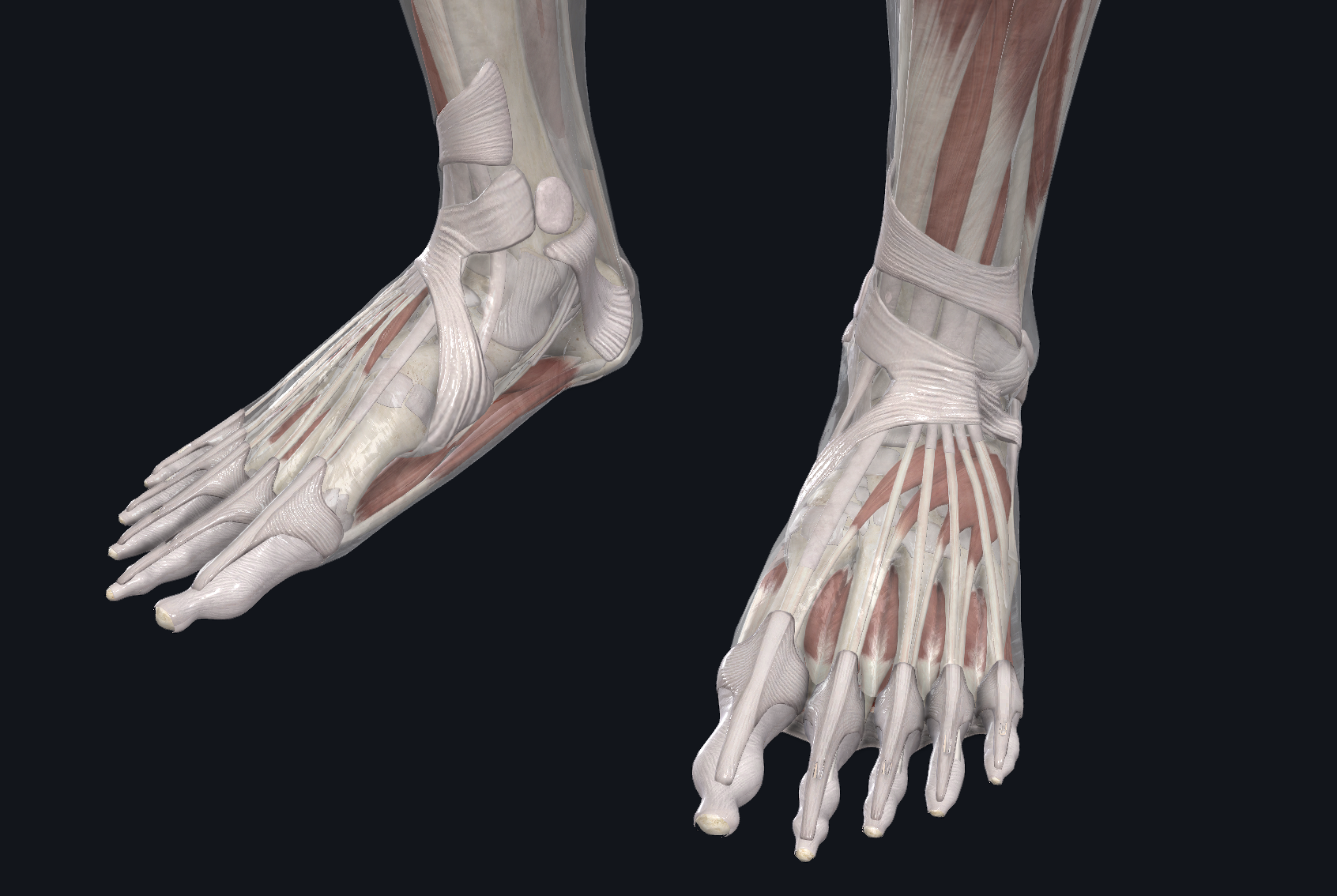
It’s all about the base.
Our amazing feet accomplish quite a feat (pun intended) in how they support and transport us for our entire lives. However, many of us have bad habits in our foot care and a lack of understanding of how important proper activation and alignment in our feet impacts our posture and health of our spine. You may be experiencing back pain and not aware that it could be stemming from a problem in your feet!
The feet are the base of our body’s kinetic chain. The kinetic chain is a term to describe the connectivity of our muscular-skeletal system. How every part (muscle, bones, tendons and ligaments) is connected to the next like cogs in a machine. When it is all working great, you feel great, but too often one of these cogs gets out of place and we can experience the ramifications up and down the kinetic chain with discomfort and pain.
Your feet are complex marvels of anatomical precision. They have 26 bones (28 if you count the two little sesamoid bones on the bottom of the big toe – some people do, others don’t, I’m not sure why!), with 30 joints and over a hundred muscles, ligaments, and tendons. As a result of this complexity, our lifestyle choices and habits often wreak havoc in uncomfortable ways.
You’ll find problems in the base of our kinetic chain in a number of ways:
- Bunions at the big toe joint (Hallux Valgus)
- Fallen arches or flat feet
- Crumpled foot syndrome (This is an unofficial term I’ve coined from seeing women who have worn shoes too tight and squeezy – the sole of the foot has a sharp crease starting between the 2nd and 3rd metatarsal)
- Morton’s Neuroma (sometimes caused by crumpled foot syndrome!)
- Plantar Fasciitis
- General misalignments (pronation or supination)
- Foot cramps
Helpful from an alignment perspective – take a look at a pair of shoes you have been wearing regularly for the past several months. Observe the wear on the shoes and notice if there are any telling patterns. Some slight wear on the outer edge of the heel is normal (neutral gait with normal amount of pronation), but it shouldn’t travel all the way up to the outer toe region (supination). If the inner heels and soles are overly worn, then you are most likely over-pronating and probably also have fallen arches.
I have personally seen tremendous improvement in all of the above conditions with simple yogic foot exercises!
Even if your feet are in great shape, and I hope they are, we can all benefit from working the feet regularly.
In this article, I:
- explore a few yoga basics of alignment and activation in the feet,
- offer a quick video on a foot massage you can give yourself – perfect for before yoga practice,
- and prompt you to consider the Mindbody Connection in relation to your feet.
This is by no means an exhaustive study, but a good starting point. These efforts at our base will energize your legs, if not your entire self. We increase circulation, improve mobility and cultivate awareness, vitality and balance.
Let’s take a look at how a few of these key actions occur.
You can do this seated or standing but get comfortable looking down at your feet.
Observe
Take a Look: Place your feet parallel on the floor (shoes and socks off!), about hip width apart, and observe the way your feet look. What is the shape and direction of the inner and outer edges of your feet? What’s going on with your toes? Are they aligned? Do you have bunions? What is the color and texture of your skin? Are there noticeable differences between your right and left foot? Don’t be disturbed if there are, no one is absolutely symmetrical. File away any new discoveries for later exploration.
Just observe what you see, and work to make the outer edges of your feet parallel…this may feel a bit strange, like you are toe-ing in…that’s okay, just go with it.
A Foot Lift
Lift and Spread: Now, we are going to work on lifting and spreading our toes…all of them! Go ahead, keeping the balls of the toes on the floor, lift up and spread your toes, making them as wide as possible (Figure 1). Notice how the tendons on the tops of your feet become pronounced, how you feel some extra activity in the lower legs, how your fingers might have gotten in on the action by lifting and spreading too…and notice how by lifting just the toes, the toe mounds had to press down firmly into the floor.
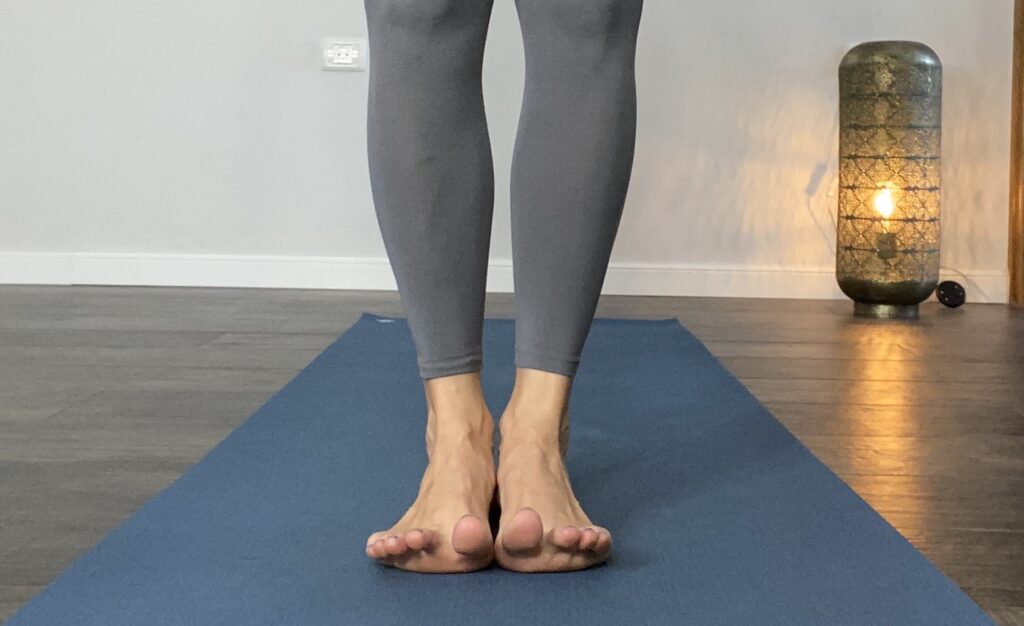
Particularly if you have fallen arches, this is a great way to shape and orient the foot into a “lifted arch” position. The arch, as we know from architecture is a very stable structure for evenly dispersing weight. That’s what we want too.
Big Toes Together: Now bring the inner edges of your feet together. Join those bunions (or just the big toe joint if there is no bunion)! We’ll take our lift and spread once more, this time, trying to bring together the inner edges of the big toe (Figure 2). Especially if you have a large bunion, those big toes are going to feel very far apart but keep trying. The effort, both mental and physical, will be putting you on the path to a more aligned foot.
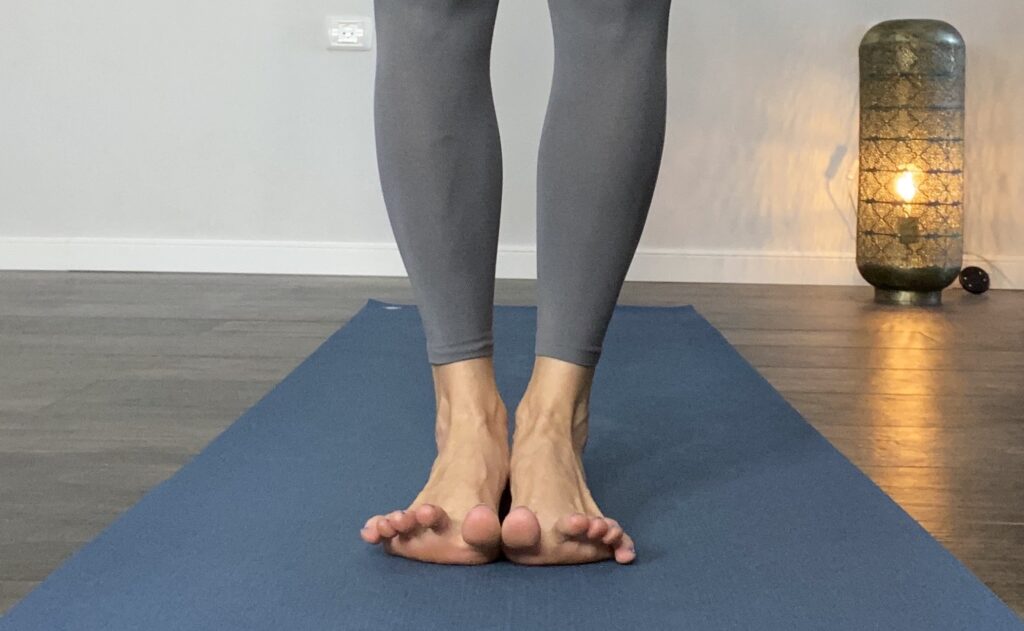
You’ll notice that the inner foot, all along the arch is working tremendously here. Practice this a couple of times to bring awareness and some strength. If you notice your foot cramping a bit, that’s normal, it is most likely a new movement. Stretch out the cramp and take a break but do try again a bit later. Over time, you will notice a connection between activating your inner foot in this way and an awakening in your inner legs.
Let the Toes Go: From this “inner foot together” position, you are going to work to maintain the even, downward press of the toe mounds and both sides of the heels but relax the toes down. Maintain the lift of those arches, just as if the toes were still raised, but soften the toes and allow them to melt to the floor. See if you can observe a heightened level of activity in the legs, especially the lower legs and a steadiness in the feet. This is more potent when done standing, as opposed to sitting.
Use Your Hands
Widen the Base: Back to sitting for a moment. Pick up one foot and rest the ankle on the opposite lower thigh, such that you can see the sole of the foot. Take your thumbs to the center of the toes mounds where you may see a crease (between the 2nd and 3rd metatarsals). Smooth and spread these toe mounds away from the center line to the edges of the toe mounds, trying to widen and spread the balls of the foot. Now do the same on the heel, smoothing the skin wide from the center to the outer edges. Repeat a few times on each foot.
Ground Down Evenly: When standing, we want to enjoy the width of these areas our feet, for stability and greater grounding of the parts of the foot that are in contact with the floor. So be sure to arrange your feet as wide as you can when standing and ground down evenly.
Your Feet in Tadasana (Mountain Pose)
Put it Together: Stand with the feet together. Activate the arches by lifting and spreading the toes. Align your toes and wake up your inner foot by joining the big toes if possible and then relaxing the toes down. Find stability by grounding down and widening the balls of the feet and the heels. How does it feel?
Weight Shifts: You may notice that there are still some wobbles, as the base is rather narrow. You can explore these natural shifts in the feet more intentionally, moving more weight to the toes, then to the heels, back and forth…as well as from the right foot to the left, side to side. Ultimately, in the basic standing posture of Tadasana, or Mountain pose, we want our hips centered on the entire foot, which means for most of us that we need to shift our weight further back to our heels.
Check it Out: Investigate this by taking a profile look at yourself in the mirror. Notice when you shift forward to your toes, your legs are at an angle (from heel to hip – Figure 3). When you shift more toward your heels, your legs are straight up and down. This is what we want (Figure 4). Just don’t overdo it with the weight moving back, as you should feel very stable in this position and not that your toes have to grip to maintain balance.
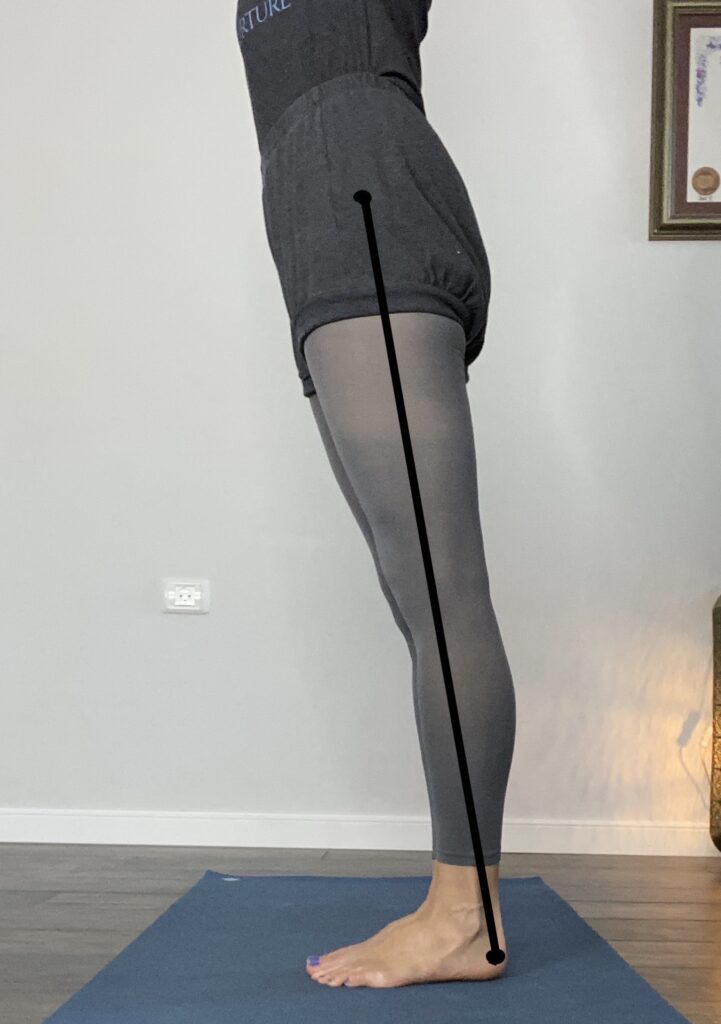
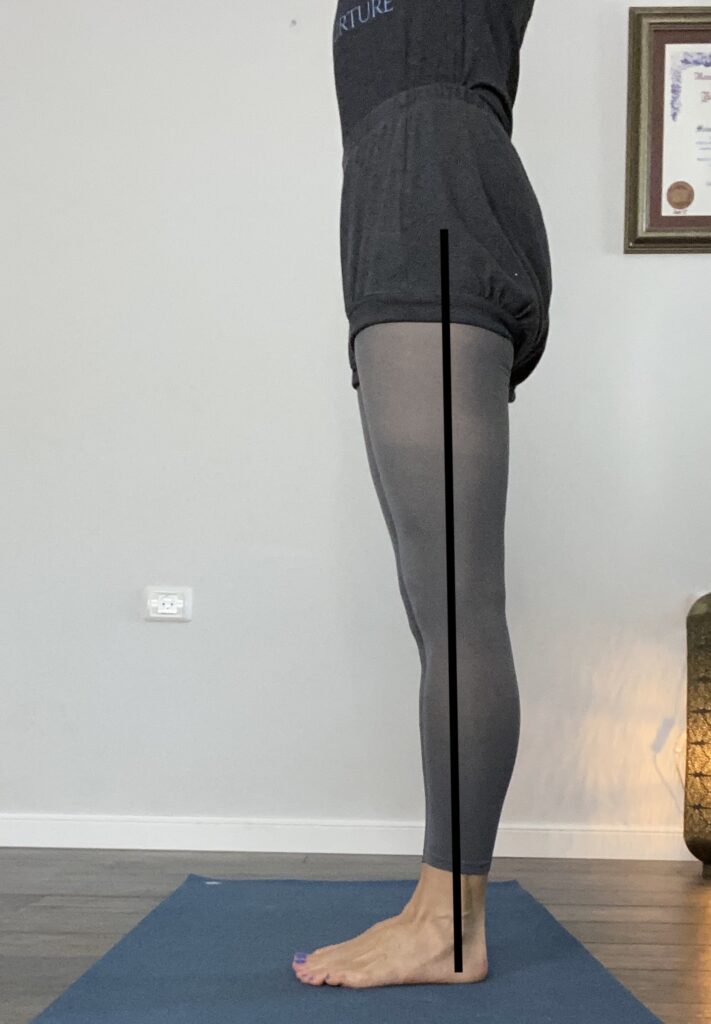
Enjoy: Stay in this position for awhile, maintaining as many of these actions as possible. Feel a new sensitivity and appreciation for your feet. Really experience the sense of touch to the floor or mat you are standing on, take a few deeper breaths, and just enjoy the simplicity of standing.
Beyond Yoga
Be sure to practice these actions when you are on your mat, but even more importantly, take them out into the world with you. Bring your newfound foot awareness to how your feet are behaving in your shoes, when you are barefoot at home, on a beach, or seated below you at your desk.
Over time, this awareness and improved alignment will give you more activated and energetic feet and legs. Your feet can become more dexterous and stronger and support you better in all of your activities. But fair warning, this amount of awareness in any body part is addictive. Further, we have only skimmed the surface of this exploration. Get yourself into some yoga classes and keep on the journey!
For an additional treat for your feet, enjoy this quick foot massage video, to improve circulation and mobility.
Mindbody Connection
Could there be more going on here?
If you are suffering from pain or injury in your feet, and in particular if this is chronic, I would explore the idea that perhaps your body is telling you something through the Mindbody Connection.
The Mindbody Connection is the understanding that our mental and emotional states, our beliefs, thoughts attitudes and feelings, positively or negatively affect our biological functioning (our physical health), and vice versa.
Interpreting our body’s messages is not always easy, and it is quite individual. A couple of questions to ask yourself:
- What do your feet do for you typically and what is the injury holding you back from?
- What are the triggers for pain?
- What is your emotional state around this injury/pain?
- What alleviates the pain (if anything)?
I also like to look at a few other modalities when trying to uncover the roots of pain.
Foot Chakra
The Chakras are the energy centers of the body. There is much emphasis placed on the seven major chakras located in the core of the body, and you are probably familiar with some (root chakra and heart chakra for example get a lot of attention). The foot chakra, though not one of these seven is still quite important. It relates to our feelings of groundedness, stability, focus, safety and connection to natural rhythms. It works in conjunction with the lowest of the seven major chakras, the root chakra. Our feet serve as the conduit of energy from the earth to self and from self to earth.
Have you ever taken off your shoes and stood in some wonderfully soft grass or earth and just felt everything inside of you settle and click? It is powerfully simple to appreciate this connection from your sense memory…we often connected to it intuitively as barefoot children, playing in the yard.
Back to those feelings of stability and safety. Consider for yourself if there are any circumstances in your life, or situations that may be compromising your feelings of stability. A turbulent parent/child relationship or spousal relationship may be threatening your sense of security. Perhaps there is fear at work for your job security. Or you may be starting out on a new venture in life, with many unknowns.
Is there perhaps a connection with some of the pain you are experiencing in your feet? We are often so programmed to look only at physical causes, especially with acute injury, as being responsible for our pain and discomfort. Once you begin to open up to the perspective that emotional and psychological pain and distress are manifested in the body as well, it is much easier to travel on a healing journey.
Consider how vital our feet are in getting us places. They literally and metaphorically, as organs of action, transport us. Appreciate how our fear of the unknown, of taking a risk, may manifest in our body trying to “protect” us with an injury that stops us in our tracks.
It will continue to hold us back, I believe, until we acknowledge and attend to the root cause. Sometimes that simple acknowledgment is enough for the pain to disappear on its own! Regardless, understanding that you are a complex, emotional, energetic being with many dimensions, and attending to all of those aspects of yourself, can nurture your physical healing in a way that no other medicine will.
Reflexology
Reflexology is the practice of applying pressure to areas of the feet to stimulate and heal the correspondingly mapped areas of the body.
As the soles of the feet are maps to the world of your body, having a trained guide to explore this map with you can be enlightening and a wonderfully pampering way to get some help with your feet.
Areas of heightened sensitivity can be indicators of imbalance in the body (muscles, bones, nerves, organs, energy, etc). The balancing work a good therapist offers can be just the boost you need to move forth in your healing journey.
Only You
Understanding the mindbody connection and how it may be playing out in your life can be helped along with the practice of yoga, with introspection, with guidance from others, and learning more about it. However, at the end of the day, it is only you that can truly know the answers. This is a very powerful stance, but full of responsibility. It is often easier to desire to entrust our health and healing to others – doctors, therapists, healers, medicines, surgeries, etc. It is a blessing to have others to give us boosts, to grant us healing, to help save our lives. But we are always an integral piece of that puzzle. Learning to trust ourselves, our intuition, is no easy task. Use the gift of hindsight to understand past mindbody connections and allow that to pave the way for current and future insights.
I don’t have an all or nothing approach. I believe in integrating all of our tools for healing and for health. If you are suffering, I recommend a truly holistic approach. What may be contributing? You are physical. Mental. Emotional. Spiritual. You are of the earth. You are what you eat. You are who you spend time with. You are what your thoughts focus on. You are of your childhood. You are the air you are breathing. You are of your future plans. You are of those you trust. You are what you believe.
Our feet are just one aspect of our multi-layered selves. Too often forgotten, too often underappreciated, too often ignored. Until they speak up! Start communicating with them now, with a grounded yoga practice, a nurturing self-care plan, and a deep appreciation for what their meaning and function is in our lives.
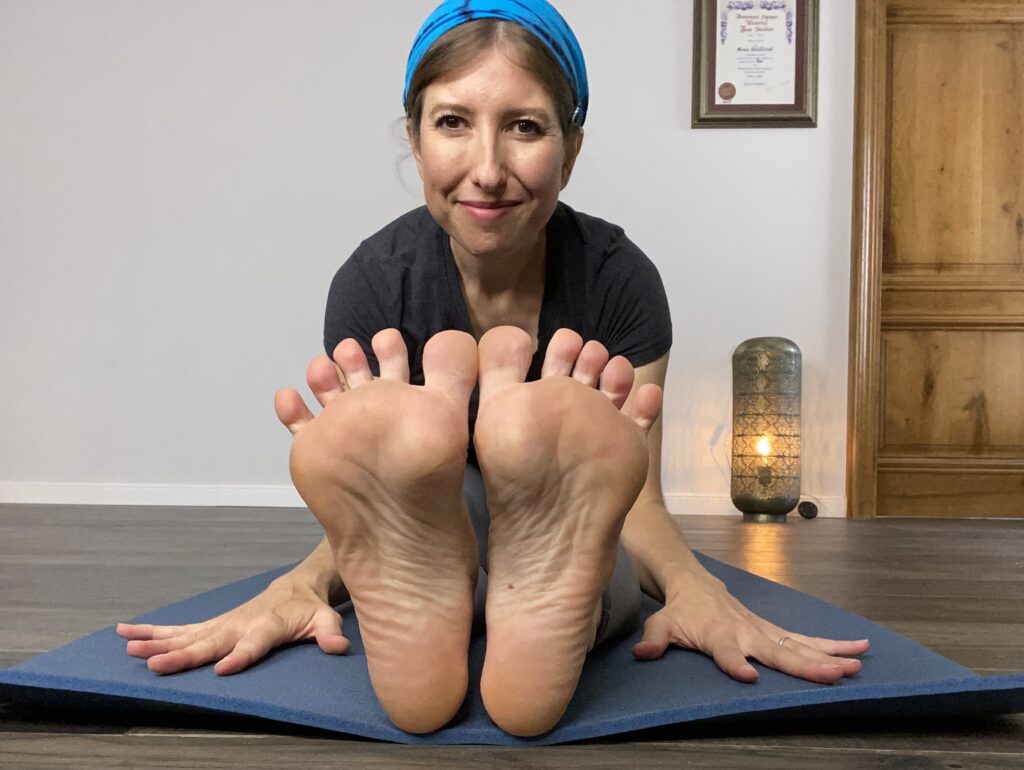

Love the newsletter! This is such great information! Can’t wait for next month! 🙂 Thank you, Sivan!
I’m so glad it is useful. Have a great month, and keep checking back here to the site, as other articles will be posted as well. Thanks for commenting.